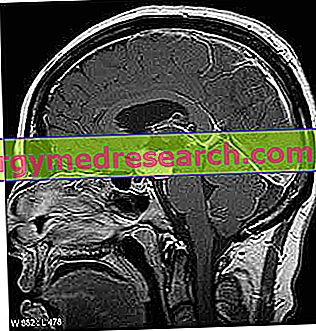Generality
A craniopharyngioma is a usually benign brain tumor, which originates in some particular cells located near pituitary glands, optic chiasm and third ventricle.

For a correct diagnosis, a fairly precise procedure must be followed, which usually begins with an objective examination and a neurological evaluation.
If the appropriate conditions exist, the most suitable treatment for a craniopharyngioma is its surgical removal.
Brief reference to brain tumors
When we talk about brain tumors, or brain tumors or brain neoplasms, we refer to benign or malignant masses of tumor cells that affect the brain (ie an area between the telencephalon, diencephalon, cerebellum and brainstem) or the spinal cord . Together, encephalon and spinal cord form the central nervous system ( CNS ).
Fruit of genetic mutations, of which however the precise cause is not known very often, brain tumors can:
- originate directly from a cell of the central nervous system (in this case we also speak of primary brain tumors );
- derive from a malignant tumor present in other sites of the body, such as the lungs (in this second case they are also called secondary brain tumors ).
Given the extreme complexity of the central nervous system and the large number of different cells that compose it, there are many different types of brain tumors: according to the latest estimates, between 120 and 130.
Regardless of their malignant power or not, brain tumors are almost always removed and / or treated with radiotherapy and / or chemotherapy, as they often cause neurological problems incompatible with a normal life.
What is the craniopharyngioma?
The craniopharyngioma is a brain tumor usually of a benign nature, which originates from residues of embryonic cells located near the pituitary gland .
In general, the tumor mass that constitutes it presents solid areas and areas filled with liquid, very similar to cysts.
Difference between a benign tumor and a malignant tumor
A benign tumor is a mass of abnormal cells that grows slowly, has little infiltrative power and an equally poor (if not zero) metastasizing power.
Conversely, a malignant tumor is an abnormal cell mass that grows quickly, has high infiltrative power and almost always a high metastasizing power.
NB: due to infiltrative power, this refers to the ability to affect adjacent anatomical regions. With metastasizing power, on the other hand, reference is made to the ability of cancer cells to spread, through blood or lymphatic circulation, to other organs and tissues of the body (metastasis).
HYPOPHYSIS: SOME BASIC INFORMATION
The pituitary, or pituitary gland, is an anatomical structure of fundamental biological importance. Indeed:
- regulates the functionality of numerous organs (including thyroid, cortical portion of the adrenal gonads );
- produces (under control of the hypothalamus) as many as 9 different hormones;
- it is involved in water metabolism and in the processes of milk secretion and body growth.

In front of the pituitary gland and to its protection there is a depression of the sphenoid bone, known as sella turcica.
POSSIBLE LOCATIONS OF A CRANIOFARINGIOMA
Craniopharyngiomas usually reside very close to the sella turcica (suprasellar position) and may, occasionally, affect the third cerebral ventricle, the optic nerve and the pituitary gland .
TYPES OF CRANIOFARINGIOMA
There are two types of craniopharyngioma:
- The adamantinomatous craniopharyngioma, characterized by numerous calcium deposits and particularly widespread in young people;
- Papillary craniopharyngioma, with few calcium deposits and more frequent in adults.
MALIGNO CRANIOFARINGIOMA
Until recently, it was believed that craniopharyngiomas were only benign tumors.
However, recent research has revealed that these tumors are also malignant, or rather that benign they can become malignant.
It happens rarely and usually involves adamanthinomatous craniopharyngiomas.
Epidemiology
The craniopharyngioma is a rare brain tumor. In fact, with an incidence of less than 2 cases per 100, 000 people, it represents 2-4% of all primary brain tumors.
It is more frequent in young people (NB: it constitutes 5-13% of all brain tumors dependent on them) and in particular among subjects aged between 5 and 14 years of age.
In adults, it is more prevalent among individuals aged 45-50 or older.
According to some studies, the most interested racial ethnicity is the African American one, while the most affected sex is the male one (NB: 55% of patients are men in almost all ethnic groups).
Causes
Craniopharyngiomas, like almost all human brain tumors, arise for reasons that are still unknown.
Furthermore, at the present time the existence of conditions or risk factors that, in some way, accompany or favor their appearance has not yet been clarified.
Symptoms and Complications
The symptoms and signs of a craniopharyngioma depend mainly on the site occupied by the tumor mass.
In fact, if the latter is close to the pituitary and compresses it, it can alter the production of pituitary hormones and determine:
- Obesity, persistent tiredness, drowsiness (or lethargy in severe cases) and dry skin. These symptoms are reported together because they all depend on an alteration of thyroid-stimulating hormone (or TSH ) levels .
- Increased thirst and / or urge to urinate. These are two effects related to the altered levels of ADH (or antidiuretic hormone ).
- In children and adolescents, growth slowing. It is a problem related to somatotropic hormone levels (or growth hormone or GH ).
If instead the craniopharyngioma resides near the optic nerve, it can lean against the optic chiasm and cause:
- Vision problems, including lower quadrantopsia (loss of a quarter of the visual field) and hemianopsia (loss of half of the visual field).
- Papilledema, or edema of the optic papilla. The optic papilla, or optic disc, is the emergence of the optic nerve within the eyeball.
Furthermore, in both cases mentioned above, the following symptoms (common to many other types of brain tumor) complete the symptomatology:
- Headache
- Nausea and vomiting, especially in the morning
- Balance problems and difficulty walking
- Sudden changes in personality or behavior
If the craniopharyngioma is particularly large it can compress both the optic chiasm and the pituitary gland and determine a very variegated symptomatology rich in problems.
HEADACHE, NAUSEA AND VOMITING
Headache, nausea and vomiting are due to an increase in intracranial (or intracranial) pressure . This increase can occur for two reasons, often concomitant:
- Because the growing tumor mass prevents the cerebrospinal fluid (or liquor) from flowing normally.
- Because edema forms around the tumor mass.

COMPLICATIONS
If prolonged, the reduced production of the hormone ADH can determine the appearance of diabetes insipidus .
Furthermore, in young patients only, a severe (and untreated) somatotropic hormone deficiency can be a reason for short stature and inappropriate physical development.
WHEN TO REFER TO THE DOCTOR?
The appearance of headache, nausea and vomiting, associated with vision problems and / or hormonal alterations - or rather with their effects - is a signal not to be overlooked and for which it is good to contact your doctor immediately.
Diagnosis
The doctors begin their diagnostic investigations by a careful physical examination and a neurological examination .
After that, they perform an eye test and some blood tests .
Finally, to dispel any doubts and to know the position and exact size of the tumor, they resort to specific tests such as:
- Nuclear magnetic resonance
- CT scan (or computerized axial tomography)
- Tumor biopsy
OBJECTIVE AND NEUROLOGICAL EXAMINATION, OCULAR TEST AND BLOOD ANALYSIS
- The physical examination involves the analysis of symptoms and signs, reported or manifested by the patient. Although it does not provide any certain data, it can be very useful for understanding the type of pathology in place.
- During the neurological examination, the doctor evaluates tendon reflexes, the presence or absence of neuromuscular disorders, the ability to coordinate, the mental state and the behavior of the person under investigation.
- Through an ocular test, the doctor observes the optic nerve and analyzes its state of health.
- The analyzes of a blood sample can be explained by the fact that the blood could contain substances indicative of the disease.
Furthermore, they allow to evaluate the level (and alterations) of some pituitary hormones, such as TSH or ACTH.
NUCLEAR MAGNETIC RESONANCE (RMN)
Nuclear magnetic resonance ( NMR ) is a painless diagnostic test that allows the visualization of the internal structures of the human body without the use of ionizing radiation (X-rays).
Its operating principle is quite complex and is based on the creation of magnetic fields, which emit signals capable of being transformed into images by a detector.
Magnetic resonance imaging of the brain provides a satisfactory view of this compartment. However, in some cases, to optimize the quality of the display, it may be necessary to inject a contrast liquid to a venous level. In such situations, the test becomes minimally invasive, because the contrast liquid (or medium) could have side effects.
A classic MRI lasts about 30-40 minutes.
TAC
CT scan is a diagnostic procedure that uses ionizing radiation to create a highly detailed three-dimensional image of the internal organs of the body.
Although it is painless, it is considered invasive due to exposure to X-rays. Furthermore, like MRI, it may require the use of a contrast agent ( gadolinium ) - not without possible side effects - in order to improve the quality of the display.
A classic CT scan takes about 30-40 minutes.
BIOPSY
A tumor biopsy consists of the collection and histological analysis, in the laboratory, of a sample of cells from the neoplastic mass.
It is the most suitable test to define the main characteristics of a tumor (typology, neoplasm starting cell, malignancy, etc.).
Usually performed in general anesthesia (therefore with the patient asleep), cells taken from a craniopharyngioma can occur in at least three different ways:
- With a special needle and after opening the skull ("open biopsy"). The skull is opened at the point where, according to imaging tests (CT and MRI), the tumor resides.
- With a special needle and under the guidance of the images provided by a CT scan ("guided biopsy"). In this case, the needle is inserted through a small hole.
- With cannulas specifically designed to be inserted through the nose and the sphenoid bone (located at the base of the skull, in front of the pituitary gland).
Histology: the cystic aspect of the craniopharyngioma
In the cysts that form part of the tumor mass of a craniopharyngioma, a viscous yellow liquid, rich in cholesterol crystals, is found.
Treatment
In the case of craniopharyngioma, the most suitable treatment is the surgical removal of the tumor mass .
If this operation is not possible or is only possible in part, radiotherapy should be used.
For malignant craniopharyngiomas, in addition to surgery and radiotherapy treatment, a treatment based on chemotherapy drugs is also provided.
If they are diagnosed with hormonal disorders, it is of fundamental importance - especially in children - to plan a hormone replacement therapy .
SURGERY
In the presence of a craniopharyngioma (as well as for all brain tumors), it is hoped that its position is completely accessible to the surgeon's hands, as this allows the total removal of the tumor mass.

In those unfortunate cases where the cancer resides in an "uncomfortable" position, the attending physician must try to remove as much tumor as possible, in order to reduce the risk of relapse.
From a strictly technical point of view, the intervention belongs to a team of neurosurgeons and otolaryngologists and consists of a subfrontal or transphenoidal excision procedure.
Disadvantages of total removal of a craniopharyngioma
Since the craniopharyngiomas form near the pituitary gland, with their total removal the neurosurgeons could damage the pituitary itself or the hypothalamus (which resides in the close vicinity).
RADIOTHERAPY
Tumor radiotherapy is the treatment method based on the use of high-energy ionizing radiation, with the aim of destroying the neoplastic cells.
It is adopted in the case of craniopharyngioma when:
- The surgical operation of removal results, due to the inaccessible position of the tumor, impractical .
- Surgical removal of the craniopharyngioma was partial . In this case, it is necessary to try to destroy the remaining neoplastic cells, in order to reduce the risk of relapses.
CHEMOTHERAPY
Chemotherapy consists of the administration of drugs capable of killing all rapidly growing cells, including cancer ones.
It can be taken into consideration in the presence of a relapse, while it is essential when the craniopharyngioma becomes a malignant tumor.
HORMONAL THERAPY
Substitutive hormone therapy consists of the administration of synthetic pituitary hormones and varies according to what the deficiencies are.
OTHER CURES
To relieve headaches and papilledema, corticosteroids are useful, as they are powerful anti-inflammatories.To treat hydrocephalus, there is a special surgical therapy, which allows the liquor to flow normally again.
Prognosis
The prognosis of a craniopharyngioma depends on:
- The size and location of the tumor mass . The more the craniopharyngiomas are large or in particularly uncomfortable positions, the more complex their total removal is.
30-50% of the removed craniopharyngiomas only partially reappear after some time (recurrence). Even this occurs 90% of the time, if radiotherapy has not been practiced after removal.
- The age of onset . Young individuals are more affected by the presence of a craniopharyngioma, especially if this alters the production of pituitary hormones.
- When the diagnosis occurred . A late-diagnosed craniopharyngioma is more difficult to treat.



